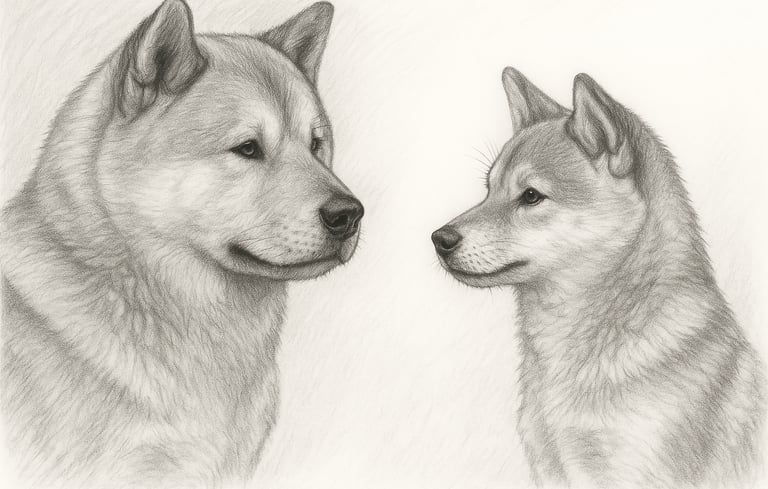Shiba Inu vs Akita Inu: Two Souls of Japan Compared
In this article, you’ll discover the physical, emotional, and personality differences between the Shiba Inu and the Akita Inu — two Japanese breeds sharing ancient origins but expressing them in very different ways. A deep comparison that goes beyond appearance.
SHIBA INUAKITA INUJAPAN
Carlo Gaspare
6/25/20253 min read
Shiba Inu vs Akita Inu:
Two Souls of Japan Compared
In the vast and fascinating world of Japanese dog breeds, the Shiba Inu and Akita Inu represent two opposing yet complementary poles — two deeply authentic ways of expressing the relationship between humans and dogs.
Their comparison goes far beyond size or temperament: it’s a cultural, emotional, and symbolic reflection that touches the core of identity and coexistence.
Morphological Differences: Shape and Expression
From a physical standpoint, the differences between the Shiba Inu and Akita Inu are evident at first glance, even for those unfamiliar with dog breeds.
The Shiba Inu is a compact bundle of energy: it stands between 36 and 40 cm at the shoulder and weighs around 8 to 11 kg. Its body is agile and well-toned, with a natural grace that evokes the balance of Japanese calligraphy.
The Akita Inu, on the other hand, commands attention with its presence: it can reach up to 70 cm in height and easily exceed 40 kg in weight. But its size is not just about bulk — it’s about posture: a living architecture of restrained power and quiet dignity.
Both breeds share the typical features of the Japanese “spitz” type: a triangular muzzle, upright ears, almond-shaped slanted eyes, and a thick tail curled over the back. Yet, upon closer observation, subtle and fascinating differences emerge.
The Shiba has a leaner, tighter build, with clearly defined musculature that seems sculpted onto its frame. It’s a dog made for motion — quick reflexes, sharp observation, instinctive escapes.
The Akita, by contrast, has a powerful physique and a stance that commands respect: broad chest, large head, deep and introspective eyes.
The Coat: Between Aesthetics and Function
Even their coats tell a story.
Both breeds have a double coat — a soft undercoat for insulation and a coarser topcoat for protection. However, the Akita’s fur is often denser and more voluminous, a trait even used as a standard in dog shows.
Permitted coat colors are similar — red, sesame, and white — but the Akita’s coloring tends to be more uniform, with smooth, creamy hues reminiscent of rice and milk.
The Shiba, on the other hand, often displays sharper contrasts, with bolder markings that seem to “paint” its expressive character onto the body.
Behavior and Personality: Two Philosophies
But it’s in behavior that the true divergence between these breeds emerges.
As if they shared a common origin, but then chose two very different paths along the road to domestication.
The Shiba Inu is a small rebel with an ancient soul. Intelligent, curious, and stubbornly independent, it often shows feline traits: it watches, chooses when to approach, and decides on its own terms when to be touched.
It doesn’t obey out of a desire to please, but out of consistency with its own internal logic.
You don’t command a Shiba — you negotiate with it. You build a dialogue.
Its reactions are sharp, its movements swift and graceful, its relationships selective and intentional.
It values its space, guards its territory, and tends to be wary of strangers.
Socialization requires patience, consistency, and respect — but once trust is earned, the Shiba becomes deeply affectionate, without ever becoming dependent.
The Akita Inu, in contrast, walks through the world with the silent calm of an ancient guardian.
Its personality is reflective, solemn, at times meditative. It is renowned for its unwavering loyalty to a single figure — a bond that can feel almost spiritual.
The Akita does not bark unnecessarily or act impulsively. It prefers to observe, understand, evaluate.
Its presence reveals a quiet nobility, a composure that feels almost human.
It thrives on routine, peace, and relationships built on trust and consistency.
Nothing can be forced on an Akita — it must be guided with respect.
It dislikes chaos and rough play, but is deeply present in daily life.
A well-raised Akita becomes a silent sentry, a devoted companion who watches over the family without invading their space.
But be warned: if hurt or betrayed, it may withdraw — and it never forgets.
Two Souls, Two Philosophies
The comparison between these two breeds reveals more than just physical or behavioral contrasts.
It speaks to two ways of being in the world — two archetypes of the Japanese spirit, expressed in canine form.
The Shiba is a young explorer: impulsive, vibrant, full of life and challenge.
It is the dog of freedom, discovery, and independence. Its eyes sparkle with curiosity, its energy demands space.
The Akita is an old samurai: silent, faithful to an invisible code.
It is the dog of memory, honor, and silent presence.
Where the Shiba runs, the Akita contemplates.
Where the first seeks to explore, the second stands to protect.
📘 Want to learn more?
Discover The Secret World of the Shiba Inu, our book dedicated to the stories, legends, and curiosities surrounding this unique breed.


